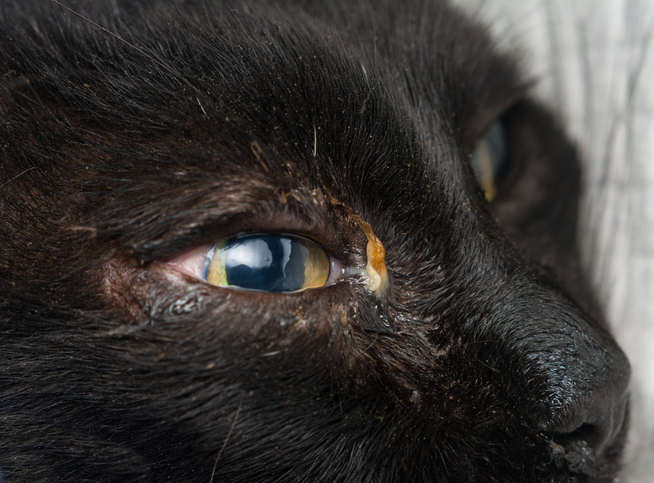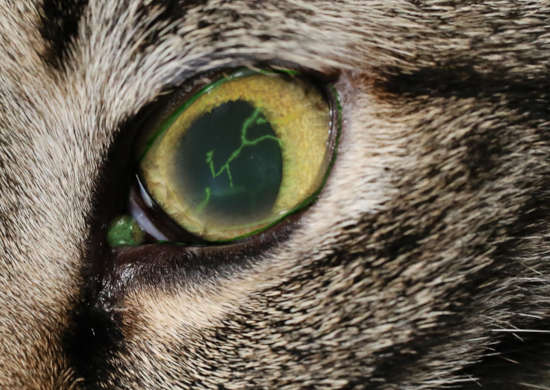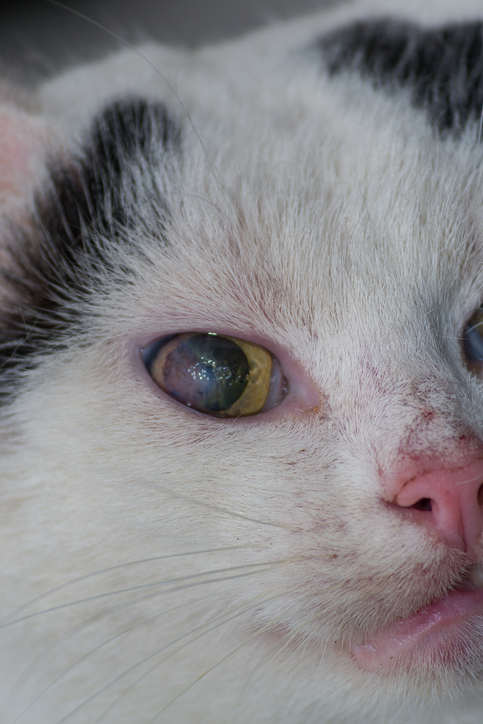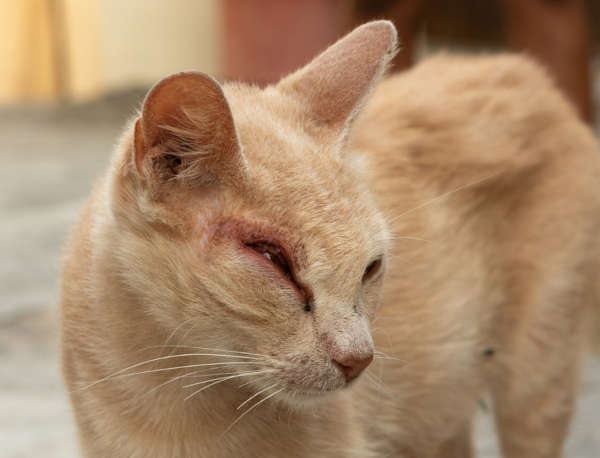Cat eyes can be susceptible to particular infections and it’s important for the owners to be aware of this. As a Veterinary Ophthalmologist, I have handled numerous eye problems in cats and treated them accordingly. In this article I will provide an overview of the various conditions and infections that can affect cat eyes along with their associated symptoms, to help you identify and treat them quickly and effectively so as to avoid any permanent damage or loss of sight.
Outline
It is critical to pay attention to your cat’s eye health in order to ensure that they don’t suffer any vision issues. If you observe any changes in your feline friend’s eyesight, make sure that you get in touch with a veterinarian right away. Similarly, if your furry companion appears to be in pain, do not hesitate and call the vet at once. Ensuring optimal eye health for cats is critical in order to maintain healthy vision.
Your cat’s eyes symptoms
When your feline friend has an issue with their eyes, some signs you may observe include:
- Pain/blinking/keeping one or both eye(s) closed
- Third eyelid protruding
- Ocular discharge or weeping
- Eye redness or swelling
- Eye cloudiness
- There is a lump developing in or around the eye
- Blindness
- Eye is bulging
- Blood in the eye
- A change in the size/shape of the pupil
Common eye conditions and infections
1. Conjunctivitis
Conjunctivitis, the most common of all feline eye disorders, is an inflammation of the thin mucous membrane (conjunctiva) that lines the inner surface of a cat’s eyelids and coats the outer surface of the eyeball. Many cats will experience at least a mild episode of the condition at some point in their lives.
Pictures of cats with conjunctivitis:
The clinical signs of the condition can be evident in either one or both eyes and will typically be observed as well in the third eyelid—the membrane positioned in the inner corner of a cat’s eye, between the lower eyelid and the eyeball.
The signs include:
- Pain/blinking/keeping one or both eye(s) closed
- Presence of a discharge that, depending on the cause of the conjunctivitis, can be either colorless and watery or thick and dark-colored.
- The conjunctiva and third eyelid become swollen and red.
The most frequent causes:
- Herpesvirus
- Calicivirus
- Chlamydophila
- Mycoplasma
- Conjunctivitis is also relatively common in cats whose immune systems have been compromised by infection with the feline immunodeficiency virus (FIV) or the feline leukemia virus (FeLV).
- Environmental irritants, such as dust or airborne chemical substances can cause conjunctivitis, as can exposure to certain outdoor plants—a condition called allergic conjunctivitis.
All cats, regardless of breed or gender, are susceptible to conjunctivitis, and the condition is not heritable. However, age is clearly a determining factor.
Although conjunctivitis can occur in older cats, this is an infection that occurs primarily in young animals. In the course of their development, young cats may pick up a virus or a bacterium from an older cat and pass it around.
Cats who have been infected with the herpesvirus can experience recurring episodes of conjunctivitis, similar to how humans may get cold sores periodically if they carry the virus. However, most cats usually build up an immunity and don’t experience recurrences of their condition.
If pet owners notice that there is something wrong with their cat’s eye, it is important to take prompt action and consult a vet. The vet will conduct a thorough examination and then determine the best course of treatment.
Picture:

2. Eye ulcers
Corneal ulcers, which are injuries sustained to the cornea of the eye, must be treated in order to resolve. If left untreated, they can result in severe consequences such as blindness.
Feline corneal ulcers have a wide variety of potential causes, including:
- Viral or bacterial infection. According to Thomas Kern, DVM, associate professor of ophthalmology at Cornell University’s College of Veterinary Medicine, the most frequent cause is recurrent infection with the feline herpesvirus (FHV).
- Cat scratches
- Ingrown eyelashes
- Foreign body
- Expose to caustic chemicals
The virus may seem to disappear, but in fact it may go on living in some of the infected cat’s nerve ganglia for the rest of the animal’s life. And from time to time, the cat’s immune system will allow the virus to escape. If the virus attacks the surface of the eye, it will cause ulceration.
The clinical signs of corneal ulceration include:
· Inflammation surrounding the cornea
· Ocular discharge or weeping
· Clouding of the cornea
· Photophobia
· Squinting, rubbing the eyes, behaving as if it is having vision problems
In order to correctly diagnose a corneal ulceration, veterinarians must thoroughly assess the animal’s medical history and examine the eye in question.
To confirm a potential ulcer diagnosis, your vet may use fluorescein eye drops. If there is an ulcer in the eye, this dye will bind to any damaged tissue and cause it to appear as a distinct greenish color on the ulcerated area.\

When treating corneal ulcers, the goal is to reduce inflammation and pain, and to ensure the ulcer is fully healed while avoiding additional infection. The type of treatment required depends on the size and extent of the ulcer.

For cats with recurrent corneal ulcers, which may be caused by the herpesvirus, additional treatment may be necessary to improve the prognosis. If pet owners notice something wrong with their cat’s eye, it is important to take prompt action and consult a vet. The vet will conduct a thorough examination and then determine the best course of treatment.
3. Eyelid infections
Blepharitis means inflammation of the eyelid.
The clinical sign include:
- Scratching or rubbing its face or eyelids leading to secondary trauma to the surrounding tissues.
- Possible discharge from the eye that may be clear, mucoid, or purulent.
- Inflammation has been present for a significant amount of time, there may also be loss of pigment or hair.
- Skin covering the eyelids may have dry crusts or flakes on its surface and small papules or pustules (pimples) may develop on the surface.
- One or more meibomian glands (glands that help lubricate the eyes) along the margin of the eyelid may become swollen.
- In more severe cases, the inflammation may spread and include conjunctivitis (inflammation of the conjunctiva) or keratitis (inflammation of the cornea).
The cause of blepharitis:
- Entropion
- Allergies
- Infections (bacteria, fungal, viral, parasites, or protozoal)

Cats that have been infected with feline herpes virus-1 (FHV-1) may develop chronic blepharitis as a secondary problem. Bacterial infections may cause localized abscesses of glands in the eyelids or generalized infections of the eyelids. In some cases, infection with Staphylococcus bacteria (staph) may lead to an allergic reaction, called Staphylococcus hypersensitivity.
- Tumors
- Trauma
- Occasionally other inflammatory disorders
Persian, Himalayan, and Burmese cats are more likely to develop blepharitis due to their facial conformation (flattened faces, and prominent folds of skin between the nose and eyes). These breeds of cats may have lagophthalmos (bulging eyes) and they are predisposed to lower eyelid entropion.
Your vet will perform a full eye examination to measure the extent of eyelid involvement. To diagnose a potential infection in your cat, your vet may take samples of its cells or secretions and look for signs of viral organisms like feline herpes virus, or bacteria.
Diagnostic labs can be used to identify any potential bacterial or viral infections and determine what kind of medication would be needed. Tests may also be run to check bacteria’s sensitivity towards certain drugs.
The prognosis depends entirely on the cause of the blepharitis. Cats infected with the feline herpes virus will remain carriers for the rest of their life and may have relapses on occasion, especially if they are stressed.
4. Feline Vision Problems
In most cases, early diagnosis and treatment can keep a cat from losing its eyesight, but it’s important to look for signs of trouble and ensure your cat gets regular check-ups.
Cause of vision problems:
- Cataract
- Glaucoma
- Progressive retinal atrophy
- Tumors
- Viruses, bacteria and fungal organisms such as feline immunodeficiency virus (FIV), the feline leukemia virus (FeLV), the feline infectious peritonitis virus (FIP), feline herpesvirus (FHV), toxoplasma (a parasitic organism) and cryptococcus (a yeast-like fungus commonly found in soil).
Among the diseases that frequently lead to feline blindness, the most common is inflammation of the uvea (uveitis), the middle area of the eye that is made up of the iris, the ciliary body (which produces the fluid inside the eye), and the choroid (which supplies nutrients to the retina). This disease, which is most often associated with FIV, FeLV, FIP and other infectious organisms, might be chronic and is likely to result in gradual blindness.
Among its signs are:
- Inflammation of the globe
- Swollen third eyelids and noticeably enlarged eyes
- Red eyes
- Pain/blinking/keeping one or both eye(s) closed
- Third eyelid protruding
- Ocular discharge or weeping
- Eye redness or swelling
- Eye cloudiness
- Blindness
- Notice blood in the eye
- A change in the size/shape of the pupil
Picture of a 12-year-old female spayed Manx cat with moderate hyphema and marked dense hypopyon bilaterally. This cat was diagnosed with lymphoma.
When you should contact your vet
Pet owners should not delay contacting the vet if they notice that something wrong with their cat’s eyes. Delaying treatment may cause the issue to worsen and might even lead to blindness. Therefore, prompt response is the key to maintaining the health of your cat’s eyes.





